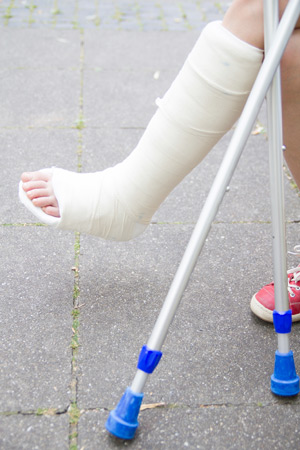Overview
Casts and splints are used to keep the bones and soft tissues lined up and protected while they are healing. A cast wraps completely around the arm or leg and is custom-made for the patient. It can only be taken off with a specialized cast saw.
Some splints are off-the-shelf from a pharmacy and are made of fabric and Velcro supported by plastic or metal. Many of these do not fit children very well as most of them are designed for adults. A custom made splint only covers half of the surface of the arm or leg and is generally covered with a soft wrap. Because of this, splints allow for swelling more than a cast does. The decision to use a cast or splint depends on the type of injury and amount of swelling.
Casts and splints also protect wounds after surgery, especially because young children don’t understand the phrase “leave it alone” and will often pick at surgical wounds. This can lead to an infection. Many times a cast is a good option to protect a wound while it heals.
Types of Casts and Splints
The hard, immobile part of most custom made casts and splints are made from plaster or fiberglass.
Plaster – plaster is white, and this is the traditional cast that most people think of when they picture a cast. Plaster is heavier and takes longer to dry after putting it on. However, it is less expensive and is able to be shaped better than fiberglass.
Fiberglass – Fiberglass is light weight and comes in a variety of colors. Bones show up much better on an x-ray when a fiberglass cast is on compared to a plaster cast. However, fiberglass does not shape as easily as plaster does.
For specfic information on hip spica casts, please continue to read but please also read the section on
hip spica casts.
Putting on the Cast/Splint
Generally, any cast or splint will have a protective layer of padding between the fiberglass/ plaster and the skin. This typically is cotton, although synthetic material such as rayon may be used. A protective cotton stocking may also be used to keep the padding from coming out from under the cast.
Both fiberglass and plaster have to be wet in order to work. The doctor or cast tech will dip the roll or strips into a bucket of water and then apply it over the padding to the arm or leg. The cast must cover enough of the arm or leg to stay secure and to keep the maximum support to the injured area. Oftentimes, this will mean that the cast has to extend past both joints above and below the injury.
If there is a lot of swelling from a recent injury, the cast may have to be split in order to allow for swelling. Plastic spacers may be placed to help keep the cast open enough for the swelling. As swelling in the arm or leg decreases over the next week or two, casts may need to be changed so that the cast can continue to closely fit around the injured area to provide support.
After the Cast is Put On
Swelling after a recent injury is normal. It is important to keep the arm or leg elevated for 2 to 3 days after the injury, especially if a cast or splint is put on. Some snugness is normal, but you should call your doctor’s office with any continued increase in pain or swelling that does not improve with elevation.
Tips to decrease swelling:
- Elevation - Keeping the injured extremity above your heart is important to allow the swelling to drain back to your body. For arm casts, keep the fingers above the elbow, the elbow above the shoulder, and the shoulder above the heart. For leg casts, several pillows propped underneath the leg with another small pillow under the ankle can help keep the leg elevated. Avoid placing the pillow under the heel and causing pressure at that area. This can cause a sore on the heel to develop.
- Movement - Wiggling toes and fingers also helps to pump the swelling back towards your heart and prevents stiffness.
- Ice - Applying a cold pack to the splint or cast can also help with swelling. Make sure there is an absorbent layer between the ice and the cast because it is important that the cast stay dry. Ice in a large plastic bag that has room to be wrapped around the cast or splint at the injured area is a better idea than a hard, rigid ice pack.
Warning Signs
Swelling is the biggest concern the first few days after the cast is put on. In rare cases, the swelling is so severe that it may cut off circulation to the hand or leg, causing nerve damage or circulation problems. Call your doctor’s office immediately if your child has any of the symptoms listed below. If it is the night or weekend, you may have to go to the emergency room.
- Increased pain or swelling in the cast that does not subside with elevation
- Numbness and/or tingling in the fingers or toes
- Burning and stinging
- Loss of motion in the fingers or toes
Taking Care of the Cast/Splint
Your doctor’s office will provide you with cast care and weight bearing/activity instructions, specific for your type of cast/splint and your injury.
- Plaster can be damaged with water, so it is important to keep the cast dry. In addition, wet padding can cause dangerous skin problems.
- Do not put anything underneath the cast, even just to scratch.
- Keep powders, dirt, and sand away from the cast.
- Do not pull the padding out from under the cast
- Do not trim off edges of the cast yourself. If there are areas of rubbing and redness, call your doctor’s office and they can trim the cast for you.
Cast Removal
Do not remove the cast yourself. You may cut your child’s skin or cause the bones to lose their alignment.
A specialized cast saw will be used. This saw vibrates, but it does not rotate like a circular saw. The saw is very noisy and may get warm. Your child may feel the vibrations from the saw. The padding under the cast will protect the skin while the saw is being used. The heat from the saw may rarely cause a superficial minor burn on the skin. Luckily, the majority of these heal are no deeper than a scrape and heal without any long term problems.
After Cast Removal
Stiffness and soreness in the arm or leg is common after coming out of the cast. This will improve over time. The dry, flaky skin is the buildup of skin that usually gets washed off in the daily bath or shower when there is not a cast. It may take a few good baths or showers to get all of the dead skin off. You may carefully use a washcloth, gentle loofah, or puff, but do not scrub so hard that it causes bleeding.
The arm or leg under the cast will often be hairier than the other side. This is normal after being in a cast. The excess hair will eventually fall off over the next few months.
Muscle strength and size decreases after being in a cast or splint. Starting range of motion and/or strength exercises is important when your doctor recommends it.
More Information
Page QR Code:


 POSNA.org
POSNA.org

